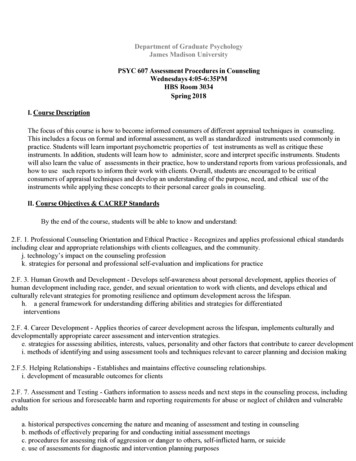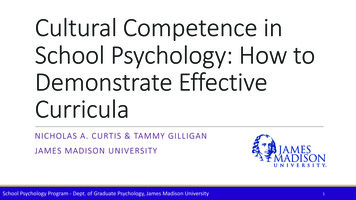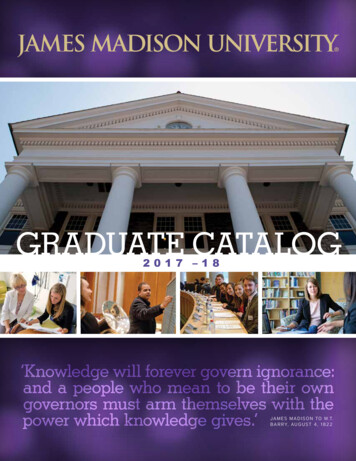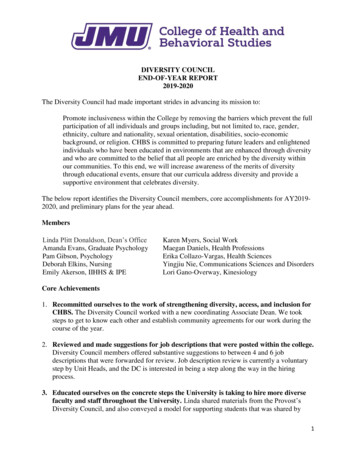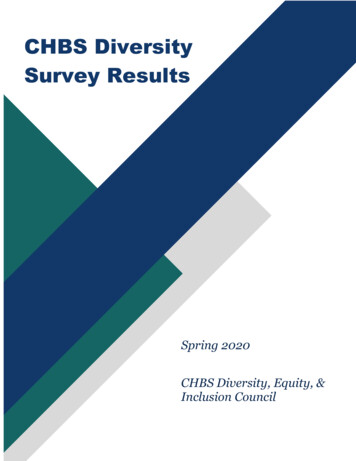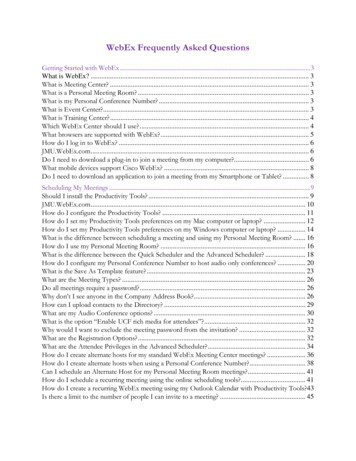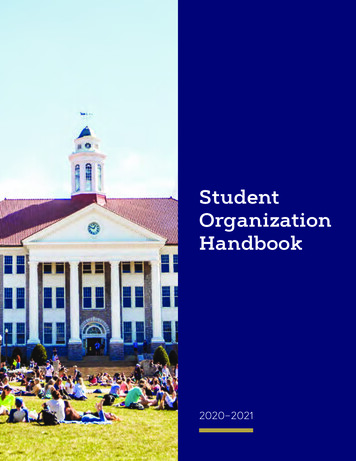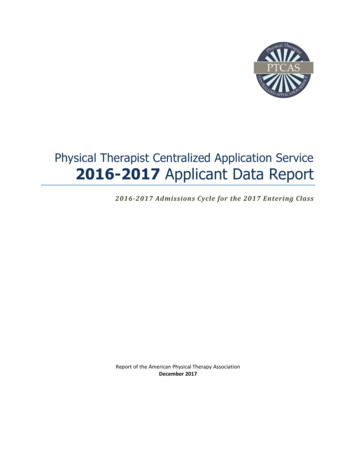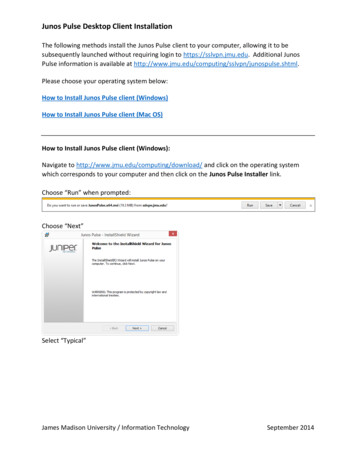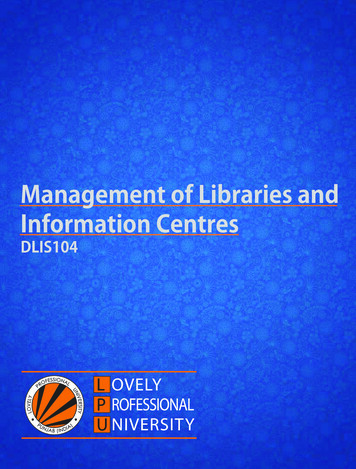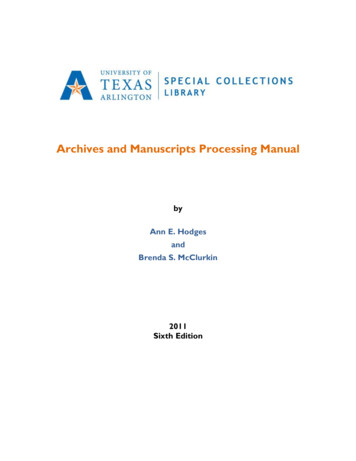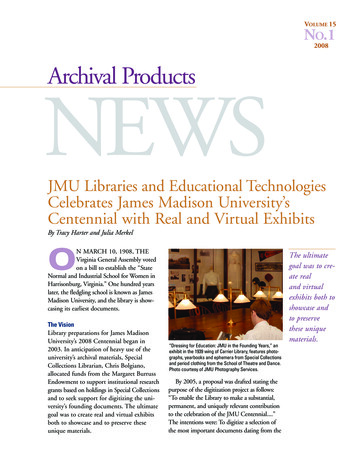
Transcription
VOLUME 15NO.12008Archival ProductsNEWSJMU Libraries and Educational TechnologiesCelebrates James Madison University’sCentennial with Real and Virtual ExhibitsBy Tracy Harter and Julia MerkelON MARCH 10, 1908, THEVirginia General Assembly votedon a bill to establish the “StateNormal and Industrial School for Women inHarrisonburg, Virginia.” One hundred yearslater, the fledgling school is known as JamesMadison University, and the library is showcasing its earliest documents.The VisionLibrary preparations for James MadisonUniversity’s 2008 Centennial began in2003. In anticipation of heavy use of theuniversity’s archival materials, SpecialCollections Librarian, Chris Bolgiano,allocated funds from the Margaret BurrussEndowment to support institutional researchgrants based on holdings in Special Collectionsand to seek support for digitizing the university’s founding documents. The ultimategoal was to create real and virtual exhibitsboth to showcase and to preserve theseunique materials.The ultimategoal was to create realand virtualexhibits both toshowcase andto preservethese uniquematerials.“Dressing for Education: JMU in the Founding Years,” anexhibit in the 1939 wing of Carrier Library, features photographs, yearbooks and ephemera from Special Collectionsand period clothing from the School of Theatre and Dance.Photo courtesy of JMU Photography Services.By 2005, a proposal was drafted stating thepurpose of the digitization project as follows:“To enable the Library to make a substantial,permanent, and uniquely relevant contributionto the celebration of the JMU Centennial.”The intentions were: To digitize a selection ofthe most important documents dating from the
JMU LIBRARIESMrs. Edna Schaeffer,Glee Club director,wearing a formalrecital dress aspictured in the 1920yearbook, the SchoolMa’am.ANDE D U C AT I O N A L T E C H N O LO G I E S – c o n t i n u e dSchool of Theatre and Dance. Numerous otherindividual contributions of technical assistanceand physical labor made the exhibit possible.With only 18 linear feet and five feet ofclearance in the micro-climate museum case,the exhibit focuses on the earliest campus fashions and accessories and features additionalphotographs and ephemera. Images werescanned and enlarged—some as high as 1200dpi depending on the dimensions of the originaland the desired enlargement size. A particularlyrelevant image from a silver gelatin print circa1910 shows the first campus buildings: Maury,Jackson, and Ashby Halls. When enlarged toposter size, a horse and cart emerged from thebackground putting the image squarely in historic perspective.Articles of clothing donated by alumnae ofthe college are juxtaposed with images of students and faculty culled from the pages of theearliest yearbooks, The Schoolma’am, (predecessor to the Bluestone). Visitors to the exhibitwitness styles change from the uniformity of“a sea of white garments” to the more colorful“roaring twenties” as hairstyles and hem lengthschange dramatically.Textiles conservator, Maureen Callahanof Richmond, was consulted for this project.State-of-the-art dress forms were purchasedand carefully padded out to help distributethe weight of fragile fabrics. Repairs were madeto seams and convey both a history of thegarments and of their wearers. One exquisitepiece, a post-war, Parisian-inspired, silk eveningdress with metallic trim is centrally featuredand shown with an image of Edna Schaeffer,the school’s choir director, in a strikingly similargarment. The dress receives less than 10 footcandles of ambient light and is illuminated bya built-in fiber optic system.establishment and earliest years of the institution that reflect the values, goals, and strategiesof administrative planning, the nature of curricular offerings, and the multiple facets of studentlife. Further, to create an attractive, user-friendly,searchable website to facilitate access to thesedocuments by a variety of patrons, from elderlyalumni to contemporary students researchingtopics in education.1The First Goal: Institutional ResearchFour faculty and staff members rose to theinstitutional research challenge: PamelaSchuelke Johnson of the School of Theatreand Dance, Richard Roberds of the College ofIntegrated Science and Technology, DanielleTorisky of the Department of Health Sciences,and Sean Crowley, library staffer and historyintern. Crowley compiled an extensive, annotated historical timeline of the first 50 yearsof JMU history. Johnson completed a majorresearch paper and digital compilation of theJMU Historical Clothing Collection. Hertome, Dressing for Education the First FiftyYears: Highlights of the JMU Historic ClothingCollection, 1908-1958 demonstrates a uniquerelationship to the larger context of social moresand fashion of the period. Roberds publishedThe History of the College of Integrated Scienceand Technology: Its Founding and the Early Years.And, Torisky submitted a History of DiningServices at James Madison University.With only18 linear feetand five feetof clearancein the microclimate museumcase, the exhibitfocuses on theearliest campusfashions andaccessoriesand featuresadditionalphotographs and The Second Goal: Centennial ExhibitsJohnson’s research project formed the basis forephemera.the first centennial exhibit in the historic lobbyof Carrier Library. “Dressing for Education:JMU in the Founding Years 1909-1929,” wasconceived by Pam Johnson; Julia Merkel,Preservation Specialist; and Johlene Hess, libraryexhibits coordinator. Student interns fromTheatre and Preservation, Anna Neubert ’09and Ashley Spencer ’07, assisted with the installation. Financial assistance came from the JMULibraries and Educational Technologies, theJMU Centennial Commission Office, and theThe Third Goal: InteractiveFounding Documents /The Founding Documents in SpecialCollections website was launched in 20072
JMU LIBRARIESANDE D U C AT I O N A L T E C H N O LO G I E S – c o n t i n u e dtext-based file, Microsoft Word. In the samevein, the “Faculty” page also provides accessto a typed transcription of meeting minutes,1909-1915. The entire handwritten volumeis accessible to compare the transcript.2These pages went through a three-stepprocess similar to the Normal Bulletinswhich were scanned at 400 ppi and savedas tiff files, followed by jpg derivativescreated and combined as pdf documents.“President Burruss” links to digital documents graciously offered by Virginia Tech,the institution that has legal ownershipand copyright of President Burruss’ papers[Citation: Julian Ashby Burruss Papers, RG2/8, Digital Library and Archives, UniversityLibraries, Virginia Polytechnic Institute andState University]. The logistics of servingthese documents has proven particularlychallenging as they were selected fromunprocessed, unarranged folders, whichwere scanned and saved as individual pdffiles with minimal identification.“Student Life,” displays full-color thumbnail images of selected student literary societyposters, Schoolma’ams, 1910-1912, andstudent handbooks, 1912-1915. The oversizeposters were scanned in segments and piecedas 400 ppi tiff files. Next, jpg derivatives weremade at 72 ppi and viewed at 800 pixels and1600 pixels on the long side for higher magnification. The handbooks and Schoolma’amswere scanned and saved as tiff files, fromwhich jpg derivatives were created, andultimately combined as pdfs.The “Timeline” link is the capstone ofthe online exhibition. The first 10 years ofCrowley’s “Annotated Historical Timeline ofJames Madison University, 1908-1959” wastransformed into an interactive, illustratedtimeline. To help users navigate, the selectedyear is highlighted and corresponds to thatselection on the timeline bar. Events andbrief descriptions from that year are listedchronologically through the center of thepage. Up to eight corresponding thumbnailThe web exhibit contains links to hundreds of earlydocuments and images in the JMU Historical collection.Viewers can navigate through five categories of documents. Architect, Charles Robinson’s, rendering of thecampus circa 1908 reveals the founders’ early ambitionsfor the school.and contains links to hundreds of earlydocuments and images in the JMU HistoricalCollection. Users can navigate to documentsand images from the following categories:Academics, Board of Trustees, Faculty,President Burruss, Student Life, and Timeline.Charles Robinson’s architectural rendering ofcampus, circa 1908, provides a visual anchor forthe site. The “Academics” page opens with anattractive 1912 diploma of Ruth RandolphConn, and to high-resolution pdf images ofearly commencement programs and NormalBulletins. The latter contain academic calendars,faculty profiles, course descriptions, expenses,and other narrative and statistical information.Files were scanned at 600 ppi and saved as tifffiles from which jpg derivatives were created at72 ppi, with 1600 pixels on the long side of theimage. Individual images were combined inAdobe Acrobat for ease of viewing. Publicationswith larger file sizes were parsed into smallerunits of less than 15mb each to reduce onscreen loading time.The “Board of Trustees” page contains a pdfversion of the typed transcription of its meetingminutes, 1908-1914. The transcription is fullysearchable because the pdf was created from a3The first10 years ofCrowley’s“AnnotatedHistoricalTimeline ofJames MadisonUniversity,1908-1959”was transformed intoan interactive,illustratedtimeline.
JMU LIBRARIESThe groupdeterminedthat a webexhibit wasmore practicalthan a searchable digitalcollection.ANDE D U C AT I O N A L T E C H N O LO G I E S – c o n t i n u e d10000XL, and a Canon EOS 10D DigitalSLR camera at 6.3 megapixels. While industrystandards for master tiff images were 600 ppiin 20035, the enormous file sizes, and limitedserver space determined that the majority ofscans be 400 ppi saved as uncompressed tifffiles. Hegg used xat’s Professional ImageOptimizer6 to batch-process service imagesas jpg derivatives of varying sizes from themaster tiff files. The derivatives workedvery well for serving the student postersbut not for multi-page documents. Multiplejpg images were combined into pdfs usingAcrobat 7.0 Professional.The “Founding Documents” website andthe “Dressing for Education” exhibition wereboth unfurled in 2007 in time for inauguralcentennial events. However facile the endresults appear, both projects took four yearsof considerable staff time in addition to hundreds of faculty research hours. Much waslearned along the way, but three areas thatshould be addressed both for future projectsand for ongoing maintenance are: metadata(the importance of metadata cannot beunderstated in digital endeavors); migrationof data; and website search options.Two of the first instructors, Natalie Lancaster (Mathematics) and Lida Cleveland (Music) on the boardwalk infront of Maury Hall, the first academic building c. 1911.Note the thick mud of a campus under construction.(JMU Special Collections #Facq111)images grace the bottom of the page. Eachentry is bookmarked to the text in the pdftimeline.3 Each thumbnail links to SpecialCollections’ JMU Historic Photos Online.4With Bolgiano’s retirement in 2005, theproverbial clock was ticking but scanningcontinued in the Center for InstructionalTechnology or “CIT” under Craig Baugher’ssupervision. However, project management wasin a holding pattern until Tracy Harter, SpecialCollections Librarian, was hired in 2006. Harterand Merkel collaborated with Sandy Maxfield,Director of Public Services; Jennifer Keach,Head of Digital Services; Bill Hartman, SystemsAdministrator; and Kevin Hegg, CIT SoftwareEngineer. The group determined that a webexhibit was more practical than a searchabledigital collection.Web manager, Greg Brown, designed thesite based on Merkel’s initial sketches and selections of images. Meanwhile, Harter coordinatedwith Baugher and Hegg to complete the scanning, create derivatives or service copies andarrange the files. Several steps were involvedin this process: the scans were placed on a temporary server; quality-controlled for consistentsizing, missing pages, etc.; files re-named;batched to create derivatives; multi-pagedocuments combined into pdfs; and finally,copied to the main library server.Imaging equipment included a MicrotekScanmaker 9800 XL, an Epson ExpressionNOTES1. JMU Founding Documents Digitizing Project Proposal.Chris Bolgiano, Special Collections Librarian, January 18,2005 (Revised Feb. 8, 2005)2. See the highlighted term “fornoon” on page 15 of the transcript. In the pdf version of the original document, a user cansee the script at close range and determine whether “fornoon”may in fact be “forenoon.”3. For examples, see specifically the entries for March 10, 1908“Harrisonburg Gets Normal: Conditions of Establishment” andNovember 25, 1908 “Maury & Jackson Halls: Groundbreaking,Construction Begins.”4. http://www.lib.jmu.edu/special/jmuphotopages/ jmuphoto.aspx5. Western States Digital Standards Group, Digital ImagingWorking Group. “Western States Digital Imaging BestPractices.” Version 1.0. January 2003. p. 24-31.6. See http://www.xat.com/ for more information.Tracy Harter, Special Collections Librarian, and JuliaMerkel, Preservation Specialist, are at James MadisonUniversity. They may be reached at harterts@jmu.eduand merkeljm@jmu.edu.4
The Next Wave of StatewidePreservation PlanningBy Tom ClaresonFties sat around the same table to discusspreservation planning issues.Following that meeting, NEH created agrant program to support statewide preservation planning, with grants of up to 50,000available. The program ran for five years andsupported preservation planning in 11 states:Massachusetts, Nebraska, North Carolina,Maine, Rhode Island, Maryland, Kansas,New Hampshire, Ohio, Pennsylvania andIowa. Because of a decline in the number ofapplications, the program was discontinuedin fiscal year 1995.While many states developed programsas a result of these statewide planninggrants, there were some which hadstatewide preservation planning effortsin place even before the NEH initiative.Many consider the New York StateProgram for the Conservation andPreservation of Library ResearchMaterials as one of the “models” for all statesto emulate. This program, administered by theNew York State Library’s Division of LibraryDevelopment, was developed throughlibrary legislation in 1984, and furtherdeveloped in 1986 and 1990 into oneof the nation’s leading programs.Key in the appeal of this project is thediscretionary grant program which providesfunding up to 30,000 annually for projects preserving research materials in NewYork’s libraries and cultural heritage institutions. Funded projects include preservationsurveys, collection microfilming, improvement in collections storage areas throughenvironmental monitoring, conservationtreatments and training. Current information on the program can be found athttp://www.nysl.nysed.gov/libdev/cp/.OR THE FIRST TIME SINCEthe mid-1990s, there is an upswingin statewide preservation planningfor libraries and cultural heritage institutions.A “Third Wave” of statewide planning hasbegun, pushed forward in part by theInstitute of Museum and Library Services(IMLS) “Connecting to Collections” program.How did this “new generation” ofstatewide efforts come about? What canthese new programs learn from some of the“classic” statewide initiatives which havesurvived for 15-20 years or longer? And,how can individual institutions across thecultural heritage spectrum take advantageof this new focus on collaborative planning?A review of the history of statewide preservation planning and the goals of currentprograms pushing these efforts forward canhelp preservation professionals knit togethera national fabric of state efforts.The ClassicsA number of statewide preservation programs have their genesis in the March 1989National Conference on the Developmentof Statewide Preservation Programs, sponsored by the Library of Congress and theDivision of Preservation and Access, NationalEndowment for the Humanities (NEH).The meeting brought together statelibrarians, state archivists and academiclibrarians from a majority of the 50 statesto develop preservation plans customized totheir constituents. Although it may be difficult to believe now, when collaboration iskey to the cultural heritage community,many representatives from the states said atthe time that this meeting marked the firstopportunity at which staff from these enti5A “ThirdWave” ofstatewideplanning hasbegun, pushedforward in partby the Instituteof Museumand LibraryServices (IMLS)“Connectingto Collections”program.
T H E N E X T WA V EThe programprovides a widearray of trainingopportunities,especiallyfocusing ondisasterprevention,preparednessand mitigation.OFS TAT E W I D E P R E S E RVAT I O N P L A N N I N G – c o n t i n u e d(http://www.ncpreservation.org/) has sponsored annual conferences and workshops ondigital preservation and audio preservationlong before these topics appeared on othergroups’ agendas.In Iowa, advocacy and informationhave ruled the day in the work of the IowaConservation and Preservation Consortium,or ICPC, a multi-institution-type organizationwhich has provided preservation informationand education for a range of membersincluding academic libraries and living historymuseums. Information on ICPC is availableat out.html.Certainly, there are other states withlong-standing preservation efforts, but manyregard these “classics” as standout programs.While not a group that usually awardsgrants, the Ohio Preservation Council,active since 1984, is a statewide programwhich includes institutions that win awards(The Cleveland Public Library, an activeOPC member for many years, was the firstpublic library to win the American Institutefor Conservation of Historic and ArtisticWorks/Heritage Preservation joint Awardfor Outstanding Commitment to Preservationand Care of Collections in 2007).Ohio’s long-standing effort focuses oneducation, with bi-annual workshops andsymposia often attracting 100 or more people,and a strong advocacy program, keepingpreservation in the public eye throughvehicles such as posters publicizing specificaspects of preservation activity. The OPCwebsite is http://opc.ohionet.org.The Massachusetts Board of LibraryCommissioners (MBLC) statewide preservation program eservationinfo/preservation.php), which began in 1988, wasone of the first to emphasize the importance of environmental monitoring andcontrol to the institutions in its state, offeringloans of environmental equipment and support for the use of that equipment to itsaudience, which began as public librariesand now includes all types of collectionholding institutions. The program provides awide array of training opportunities, especiallyfocusing on disaster prevention, preparednessand mitigation. Information on a variety ofprogram offerings including emergency assistance, preservation needs assessments and sitesurveys, is available online through this welldocumented program.What makes the programs in NorthCarolina and Iowa successful and sustainable?The North Carolina Preservation Consortium(NCPC) has a history of developing conference programs that are “ahead of the curve”of many other organizations and associations’preservation education efforts. NCPCThe Second WaveIn the early 1990s, assisted by the StateLibrary of California, preservation professionals from a variety of institution types,in this case ranging from libraries to stateparks, to museums, came together todevelop a program which is now seen asone of the strongest and most comprehensive statewide preservation programs inthe United States.Initially begun through NEH-fundedplanning, the project took off in 1997with a large-scale preservation needs assessment survey, which uncovered education,information and consulting need
University.Theymaybereachedatharterts@jmu.edu andmerkeljm@jmu.edu. Two of the first instructors, Natalie Lancaster (Mathe - matics) and Lida Cleveland (Music) on the boardwalk in front of Maury Hall, the first academic building c. 1911. Note the thick mud of a campus under construction. (JMU
